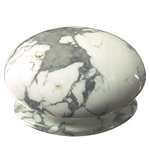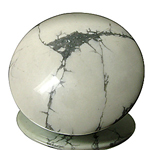Howlite
Rather rare mineral of the borate class.
Origin of name: named after the Canadian mineralogist, geologist and chemist Henry How (1828-1879), who firstly described the mineral, which had been found in a gypsum quarry, in 1868. How originally called it "silico-boro-calcite". Later it was named in his honour by famous mineralogist and geologist James Dwight Dana.
Synonyms and trade names: occasionally white (undyed) Howlite is sold as "white turquoise", "white buffalo turquoise" or "white buffalo stone". The true "white buffalo turquoise" is a white, chalk-like, low grade turquoise found in Tonopah, Nevada.
Can be confused with: untreated howlite can hardly be confused with anything else. However, howlite (as well as magnesite) are often dyed to imitate turquoise. Both these imitations are marketed under the trade name "Turquenite".
Localities: Canada (Nova Scotia), USA (California), Turkey, Germany (Kohnstein quarry near the village of Niedersachsenwerfen).
Handling: howlite is soft and brittle. It has to be stabilized and hardened with e.g. synthetic resin, to be suitable for cutting and polishing. Very susceptible to acids!. Contact with diluted hydrochloric acid will turn howlite into a gelatinous silica!
Worth knowing: in gemmological literature the hardness of howlite is stated as 3-3.5
This is valid for the nodules, in which howlite is usually found. However, in Iona, Cape Breton Island, Nova Scotia, Canada single crystals have been found, the hardness of which tested to be up to 6.5


 Deutsch
Deutsch